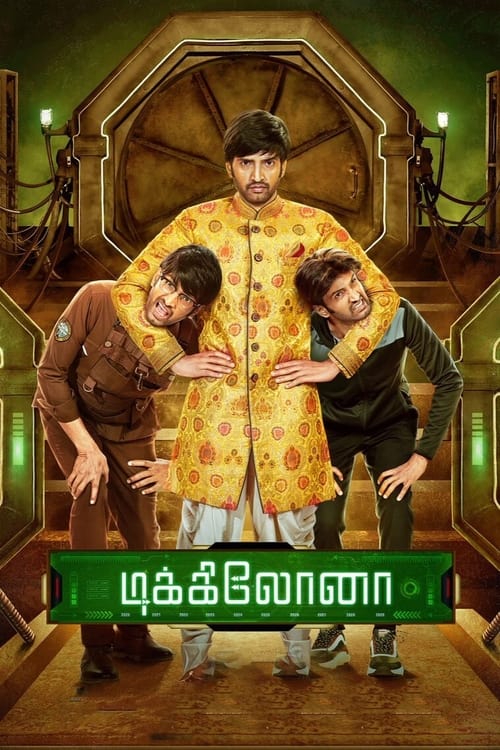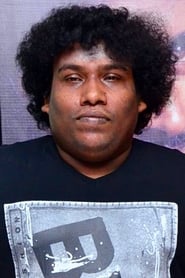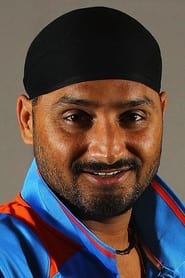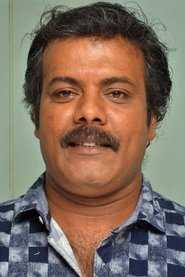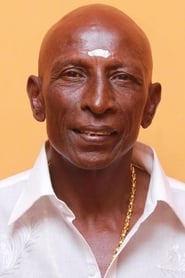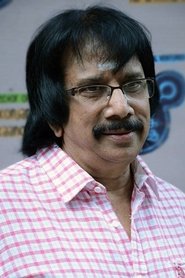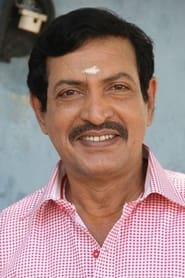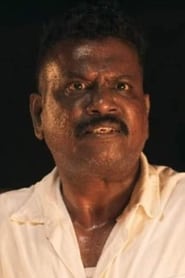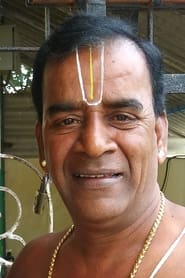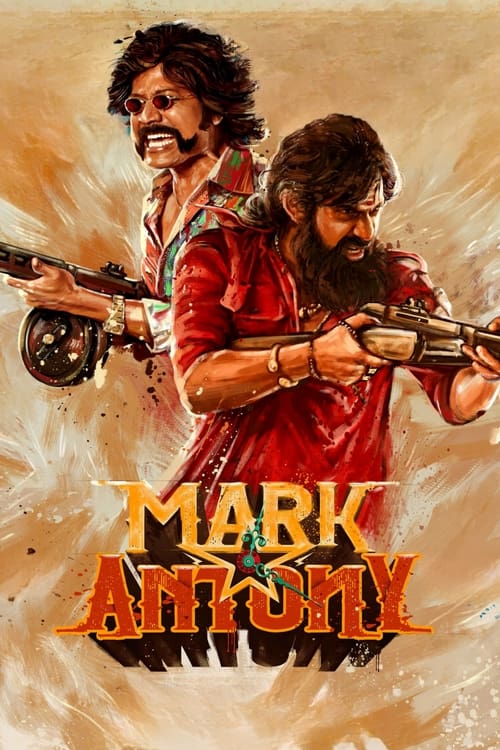
Ask Your Own Question
What is the plot?
Dikkiloona: Complete Plot Narrative
The year is 2027, and Mani, an electricity board lineman, walks through the corridors of his life carrying the weight of profound dissatisfaction. His marriage to Priya has become a source of constant frustration--he views her as nothing more than a nagging, troublesome presence in his existence. Every interaction with her feels like a burden, and Mani has convinced himself that if he could simply erase this marriage from his past, his life would transform into something worth living. This singular obsession will soon consume him entirely, setting in motion a series of events that will test the very fabric of reality itself.
One fateful day, while navigating the streets of 2027, Mani stumbles upon something extraordinary hidden beneath the urban landscape. He discovers a dilapidated car boot that leads downward into an underground laboratory teeming with scientists working feverishly on an impossible dream--a functional time machine. The scientists have been laboring for decades on this project, but they remain frustratingly close to success while simultaneously stuck at an impasse. They possess the vision and the theoretical knowledge, but one crucial element continues to elude them: the complete formula needed to make the machine operational.
Within this clandestine laboratory, Mani encounters Albert, played by Yogi Babu, who works as the lab's janitor. Albert is no ordinary custodian, however. He is Mani's childhood friend, someone from his past whom he hasn't seen in years. The reunion is unexpected, but what happens next changes everything. During their conversation, marked by Mani's trademark insults and meaningless banter, an accident suddenly erupts. A surge of electrical energy flows through the laboratory with catastrophic force. Albert, caught directly in the path of this surge, loses consciousness as the electricity courses through his body.
The accident triggers something remarkable--the time machine, dormant and seemingly useless for so long, suddenly springs to life. For the first time in decades, the machine begins to function. But this awakening comes with a terrible price: the machine threatens to explode, and if it does, the entire laboratory and everyone in it will be destroyed. The scientists scramble desperately, their minds racing to find a solution. They need the formula--the missing piece that will allow them to shut down the machine before catastrophe strikes.
Then, miraculously, Albert awakens. The school dropout who has spent his life as a janitor, someone with no formal education and no scientific training, opens his eyes and begins to speak. The electrical shock has fundamentally altered his brain chemistry, granting him the intellectual capacity of Albert Einstein himself. Albert recites the formula with perfect precision, and the scientists frantically input the data into the system. The machine stabilizes. The explosion is averted. The impossible has become possible.
Mani witnesses this miracle, and in that moment, a thought crystallizes in his mind with absolute clarity: if a time machine truly exists and is now functional, he can use it to change his past. He can go back to 2020, to the day of his wedding, and prevent the marriage from ever happening. He can erase Priya from his life before she becomes the source of his misery. The scientists, recognizing an opportunity, decide to test their creation. They will send Mani back in time.
But first, Mani encounters his alternate self--EB Mani, a version of himself from a different timeline who has already lived through the consequences of time travel. EB Mani is desperate to prevent groom Mani from making the same mistakes he has made. He pulls out a video, something incriminating, something that could destroy groom Mani's life if it were to be released. EB Mani blackmails him with this footage, threatening to circulate it to everyone unless groom Mani agrees to stop his marriage. The threat is clear and absolute: cancel the wedding, or face complete social destruction.
To facilitate this mission, EB Mani gives groom Mani an exit watch, a device that will allow him to travel through time. He instructs groom Mani to use it to journey to 2027, telling him that once he experiences what life becomes in that future year, he will finally understand why the marriage must be stopped. The logic seems irrefutable: see the future, understand the consequences, and make the right choice.
Groom Mani activates the exit watch, and the world dissolves around him. When reality reforms, he finds himself standing in 2020, on the day of his wedding. The mandap awaits. Priya waits. Everything is exactly as it was, frozen in time, waiting for him to make his choice. Mani's heart races with anticipation. He believes he is about to liberate himself from a lifetime of misery.
But the universe has other plans. The decision to stop the wedding creates a ripple effect that tears through the fabric of reality itself. Mani finds himself experiencing multiple timelines simultaneously, each one a different version of what his life becomes based on his choices. In one timeline, he successfully prevents the wedding. Priya, devastated and alone, finds work as a waitress in a small restaurant. When Mani encounters her in this timeline, she is a shadow of her former self, broken and remorseful. She apologizes to him for forcing him to marry her when she knew he was unwilling. But there is something far more devastating in her confession: she reveals that she was pregnant on their wedding day. After Mani stopped the marriage, she made the agonizing decision to abort their child. The guilt has consumed her. She has spent years carrying the weight of that choice, and now, seeing Mani again, she can only express her deep regret.
In another timeline, Mani attempts a different approach. He decides not to marry Priya but instead pursues Meghna, Priya's friend. Meghna had been trapped in an unhappy marriage that ended in divorce. She had openly expressed her interest in Mani, asking him to abandon Priya and choose her instead. Mani, seizing what he believes is his opportunity for happiness, manipulates events to be with Meghna instead. But when he finally achieves this goal, he discovers something horrifying: he is just as miserable with Meghna as he was with Priya. The problem, he realizes with crushing clarity, is not his wife. The problem is him. He is a self-centered, indifferent man who blames everyone around him for his unhappiness. He is a misogynist who cannot accept Meghna's past, her seven years of living with another man before her divorce. No matter what external circumstances change, his internal character remains fundamentally flawed. Changing his wife cannot change who he is.
The mental anguish of experiencing these multiple timelines simultaneously drives Mani to the brink of madness. He finds himself institutionalized in a mental asylum, surrounded by eccentric patients and an equally eccentric doctor. He struggles through the days and nights, his mind fracturing under the weight of infinite possibilities and infinite failures. Time becomes meaningless. Reality becomes questionable. He exists in a liminal space between sanity and complete dissolution.
Then, at the precise moment when EB Mani sends groom Mani forward to 2027, something extraordinary happens. Mani, the version who has been institutionalized and has experienced all the consequences of his choices, arrives back at the wedding scene in 2020. Now there are three versions of Mani present simultaneously: groom Mani, who is confused and uncertain; EB Mani, who is desperate to prevent the wedding; and new Mani, who has lived through the horrors of the alternate timelines and has emerged with hard-won wisdom.
The three Manis introduce themselves collectively as Goundamani, a name that captures the absurdity and confusion of the moment. Groom Mani is bewildered. EB Mani urges him to stop the wedding, repeating his warnings about the misery that awaits. But new Mani, the one who has suffered and learned, tells groom Mani something entirely different. He tells him not to stop the wedding. He explains, with the weight of experience behind every word, what he has learned in the alternate timelines.
New Mani reveals a crucial truth that groom Mani never knew: Priya is pregnant. She has been carrying their child within her, and she is not the terrible person that groom Mani has convinced himself she is. She is a woman who loves him, who is willing to stand by him, who deserves his honesty and his presence. New Mani tells groom Mani that true happiness does not come from changing circumstances or changing partners. It comes from changing oneself, from becoming honest, from accepting another person fully and completely.
Groom Mani, shaken by this revelation, rushes to find Priya. He reaches her just minutes before the wedding ceremony is scheduled to begin. Standing before her, he speaks words that come from a place of genuine vulnerability. He tells her that he may or may not become a successful person in the future. He cannot promise her wealth or status or security. He cannot promise her that life will be easy or that he will always be perfect. But he is asking her something far more important: is she willing to accept him as he truly is, with all his flaws and uncertainties, and marry him anyway?
Priya's response comes not in words but in action. She arrives at the mandap, the wedding altar, and stands beside Mani. She tells him that she is ready to marry him because he has finally told her the truth. For the first time, he has been honest with her. For the first time, he has acknowledged her reality and her worth. Priya and Mani marry, their union sealed not by perfect circumstances but by genuine acceptance and honesty.
As the ceremony concludes, EB Mani and new Mani feel themselves being pulled away from this timeline. They disappear into their own timeline, their mission complete. The wedding that was supposed to be prevented has instead been saved, transformed from an act of coercion into an act of genuine commitment.
The film then shifts forward to show Mani's life in 2027, but this is a different 2027 than the one he left behind. In this timeline, Mani has become a successful hockey player. He is a father to a daughter. He is still married to Priya. But more importantly, he has changed as a person. When Priya screams at him for silly reasons, as she inevitably does, Mani no longer responds with irritation and resentment. Instead, he sees her in a completely different light. He understands that her passion, her emotion, her engagement with life--these are not flaws to be resented but qualities to be cherished. He has learned that happiness is not found in escaping one's circumstances or one's partner, but in transforming one's perspective and one's character.
Meanwhile, Meghna, Priya's friend, receives a proposal from Karthik. Her story, which could have been one of loneliness and regret, instead becomes one of hope and new beginnings. She finds happiness not through manipulation or through being chosen as a second option, but through genuine connection with someone new.
The film concludes with this vision of transformed lives, each character having learned something essential about themselves and about the nature of happiness. Mani's journey through multiple timelines, his descent into madness, his confrontation with his own character flaws--all of it has led him to a single, profound realization: the only person he ever needed to change was himself. The time machine, the technology that seemed so miraculous, ultimately proves to be less important than the internal transformation that occurs within Mani's heart and mind. He cannot escape his past, but he can transform his relationship to it. He cannot change his wife, but he can change how he sees her. He cannot rewrite his history, but he can create a different future by becoming a different person.
The exit watch, the blackmail video, the laboratory hidden beneath the city--all of these elements fade into insignificance compared to the simple truth that Mani discovers: true freedom comes not from changing external circumstances but from changing oneself. The time machine promised him escape, but what he actually needed was acceptance--acceptance of himself, acceptance of Priya, acceptance of the messy, complicated reality of human relationships. In the end, Mani does travel through time, but not to escape his past. He travels through time to understand that his past, his present, and his future are all interconnected, and that the only way forward is through honest engagement with all of it.
What is the ending?
In the ending of "Dikkiloona," the protagonist, a man named Karthik, ultimately learns to embrace his past mistakes and the importance of love and relationships. He reconciles with his estranged wife, Anu, and they find a way to move forward together. The film concludes with a sense of hope and renewal as Karthik realizes the value of second chances.
As the climax of "Dikkiloona" unfolds, we find Karthik in a state of turmoil, grappling with the consequences of his actions. The scene opens with Karthik standing in a dimly lit room, the weight of his choices pressing heavily on his shoulders. He reflects on the time travel experience that has allowed him to revisit pivotal moments in his life, particularly his relationship with Anu. The emotional turmoil is palpable as he recalls the love they once shared, now overshadowed by misunderstandings and regrets.
In the next scene, Karthik confronts Anu, who is initially hesitant to engage with him. The tension is thick as they exchange words filled with hurt and longing. Karthik's eyes are filled with desperation as he pleads for a chance to explain himself, to show her that he has changed. Anu, torn between her feelings and the pain of their past, struggles to maintain her composure. The room is charged with emotion, and the audience can feel the weight of their shared history.
As the conversation progresses, Karthik reveals the lessons he has learned through his time travel. He speaks earnestly about the importance of cherishing moments and the people we love. Anu's defenses begin to lower as she listens, her expression softening. The scene shifts to flashbacks of their happier times together, interspersed with Karthik's heartfelt confessions. The visuals of their laughter and shared dreams contrast sharply with the current tension, highlighting the depth of their connection.
In a pivotal moment, Karthik takes a step closer to Anu, his voice trembling with sincerity. He acknowledges his past mistakes and expresses his desire to make amends. Anu, moved by his vulnerability, finally allows herself to open up. Tears well in her eyes as she shares her own struggles and the loneliness she has felt since their separation. The emotional exchange culminates in a powerful embrace, symbolizing their willingness to forgive and rebuild their relationship.
The final scenes depict Karthik and Anu embarking on a new journey together. They are shown walking hand in hand through a sunlit park, laughter echoing around them. The camera captures their smiles, a stark contrast to the earlier tension, signifying hope and renewal. Karthik's transformation is evident; he has learned to appreciate the present and the love he has in his life.
As the credits roll, the audience is left with a sense of closure for Karthik and Anu. Karthik's journey has taught him the value of love, forgiveness, and the importance of living in the moment. The film ends on a hopeful note, emphasizing that while the past may shape us, it is our choices in the present that define our future.
Is there a post-credit scene?
Yes, "Dikkiloona" features a post-credit scene that adds a humorous twist to the film's narrative. After the main credits roll, the scene opens with the protagonist, played by Santhanam, in a light-hearted and comedic situation. He is seen interacting with a group of friends, who are discussing the events that transpired throughout the film.
As they reminisce about the time travel and the various mishaps that occurred, one of the friends jokingly suggests that they should try time travel themselves. This leads to a series of comedic exchanges where they speculate on what they would change in their own lives if they had the chance to go back in time. The scene is filled with laughter and banter, showcasing the camaraderie among the characters.
The humor is punctuated by Santhanam's signature comedic timing, as he delivers witty one-liners and reacts exaggeratedly to his friends' suggestions. The scene wraps up with a playful cliffhanger, hinting at the possibility of more adventures, leaving the audience with a sense of joy and amusement as they exit the theater. This post-credit moment reinforces the film's light-hearted tone and the theme of friendship, making it a fitting conclusion to the story.
What is the significance of the time travel element in Dikkiloona?
In Dikkiloona, the time travel element serves as a crucial plot device that allows the protagonist, played by Santhanam, to revisit pivotal moments in his life. This journey through time is not just a means to alter past mistakes but also a way for him to confront his emotional struggles and insecurities. The time travel sequences are visually represented with vibrant colors and dynamic transitions, emphasizing the contrast between his past and present. As he navigates through these moments, the audience witnesses his internal conflict and growth, making the time travel a significant aspect of his character development.
How does the character of Santhanam evolve throughout the film?
Santhanam's character begins as a man burdened by regret and dissatisfaction with his life choices, particularly in his romantic relationships. As the story unfolds, his encounters with his past selves during the time travel sequences reveal his vulnerabilities and fears. Initially, he is portrayed as comedic and carefree, but as he confronts the consequences of his actions, he becomes more introspective. The emotional weight of his journey is highlighted through poignant moments of realization, where he learns the importance of love, responsibility, and self-acceptance, ultimately leading to a more mature and grounded version of himself.
What role does the character of the antagonist play in Dikkiloona?
The antagonist in Dikkiloona serves as a catalyst for the protagonist's transformation. This character embodies the challenges and obstacles that Santhanam's character must face, representing the darker aspects of his past decisions. The antagonist's motivations are rooted in jealousy and revenge, which adds tension to the narrative. Their confrontations are filled with both comedic and dramatic elements, showcasing the protagonist's struggle not only against external forces but also against his own inner demons. This dynamic creates a compelling conflict that drives the story forward and ultimately leads to Santhanam's growth.
How does the film portray the theme of love through its characters?
Dikkiloona intricately weaves the theme of love through its characters, particularly through Santhanam's relationships with his love interests. The film explores various facets of love, from infatuation to deep emotional connections. Through his time travel experiences, Santhanam revisits moments with his past love, allowing the audience to see the evolution of their relationship. The emotional highs and lows are depicted with heartfelt dialogues and tender moments, emphasizing the importance of communication and understanding in love. The film ultimately suggests that true love requires growth and sacrifice, as Santhanam learns to appreciate the people in his life.
What are the key comedic elements in Dikkiloona and how do they enhance the story?
The key comedic elements in Dikkiloona are woven throughout the narrative, primarily through Santhanam's character and his interactions with others. The humor often arises from situational comedy, misunderstandings, and witty dialogues that provide levity amidst the more serious themes of the film. For instance, Santhanam's attempts to navigate his time travel mishaps lead to humorous scenarios that highlight his clumsiness and charm. These comedic moments not only entertain but also serve to balance the emotional weight of the story, making the character's journey more relatable and engaging for the audience. The humor ultimately enhances the overall narrative by providing a contrast to the deeper themes of love and self-discovery.
Is this family friendly?
"Dikkiloona," produced in 2021, is a Tamil science fiction comedy that features a mix of humor, romance, and fantasy elements. While the film is primarily aimed at entertaining a broad audience, there are certain aspects that may not be suitable for younger viewers or sensitive individuals.
-
Mature Themes: The film explores themes of love, relationships, and personal growth, which may include discussions or situations that are more appropriate for older audiences.
-
Romantic Content: There are romantic scenes that may involve suggestive dialogue or situations that could be uncomfortable for younger viewers.
-
Comedic Elements: The humor in the film often includes slapstick and situational comedy that may not resonate with all audiences, potentially leading to misunderstandings or discomfort.
-
Emotional Turmoil: Characters experience emotional struggles, including heartbreak and regret, which may be intense for sensitive viewers.
-
Fantasy Violence: As a science fiction film, there may be scenes that involve fantastical elements or mild violence that could be unsettling for children.
Overall, while "Dikkiloona" is designed to be entertaining, parents may want to consider these elements when deciding if it is suitable for younger audiences.

